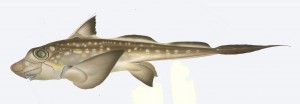Earlier this month we received a question on one of our past posts, The Ghost Sharks of the Jurassic, asking:
“Do we know when these chimaeras shifted to deep-water habitats? If predation and, in particular, the evolution and diversification of predatory species prompted their geographic transition, at what point would a sort of critical level have been reached to drive them into the deep? How many predators are too many?”
Why do “living fossils of the deep sea” so often represent lingering survivors of groups that long ago flourished in shallow water?
 |
| Rabbitfish |
Examples: Rabbitfish (aka chimaeras), Coelacanths, Goblin Sharks, Giant Squid.
Excellent question – one that keeps evolutionary biologists awake at 2 a.m.
First thing: we never know when a clan of species invades deep water. This is why:
Sediments deposited on top of oceanic crust in deep-water – thousands of feet deep – rarely come to the surface where the layers can be seen by fossil-hunting paleontologists. Mud does form at the bottom of deep seas and fossils do form here. But such deep specimens have a low chance of being found by us.
Deep sea bottom mud is raised above sea level when continents collide and abyssal sediment is squeezed up and thrust across slabs of continental crust. There are narrow zones of such squeezed sediments – for example, in the Taconic Mountains of New York State. Here are slices of deep crust and sediment with deep-water trilobites. However, very few vertebrate and squid fossils are known from squeezed deposits.
Medium-deep sediment, up to 200 meters deep, do form in the bottom of “epi-continental seas” like the famous “Cretaceous Ocean of Kansas” that covered much of the central areas of North America. Such epi-continental seas do drain away, and the bottom sediment becomes lifted hundreds or thousands of feet, so wind and water can erode valleys into the rock layers, exposing fossils. Epi-continental sea bottoms have given us 90% of our marine vertebrate and cephalopod fossils.
Coelacanth fossils are common in shallow-water and medium-deep sediments beginning in the Early Devonian, over 400 million years ago. From then on, coelacanths remain widespread and often common. Were they in deep water too? We don’t know – we don’t have enough deep sediment exposed for study.
Abruptly, coelacanths disappear from epi-continental sea deposits in the Late Cretaceous. Naturally, we thought they were extinct. But then the fish show up alive and well, hanging around at 130 meters to 700 meters.
Ditto for the Goblin Shark: common as a fossil along New Jersey in shallow sediment but now restricted to much deeper waters. Ditto for the giant squid, who left their shells in the Cretaceous epi-continental sea sediment but now prefer deeper water.
 |
| Goblin Shark |
Is there a common explanation for all the survivors in deep waters?
The most popular theory is: 1) Most new types of fish and cephalopods first evolve in shallow water. 2) It takes time for evolution to modify a fish or cephalopod so the beast can survive at 200m + depths. So the early coelacanths couldn’t colonize the great depths for tens of millions of years. As more and more clans of fish evolved in shallow water, some began their adaptive descent too – but the coelacanth had a head start. Being fully adapted to great depth already may have protected the fish from predators and competitors who are behind in the degree of their transition.
There are holes in the theory. Coelacanths do have predators – they show up in shark stomachs. They must have competitors too – teleost fish with more complex jaws.
Deep Sea Refuges continue to irritate our neat little hypotheses.
WAnt more? See the past post on ghost sharks and full comment.
© 2009 Houston Museum of Natural Science, One Hermann Circle Drive, Houston, TX 77030




















